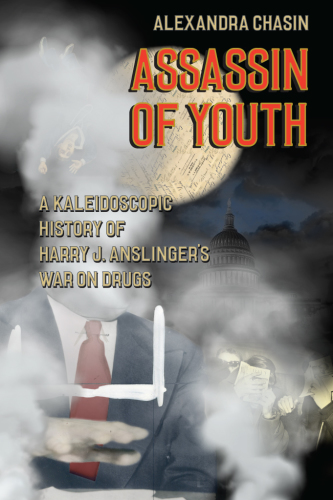
Assassin of Youth
A Kaleidoscopic History of Harry J. Anslinger's War on Drugs
کتاب های مرتبط
- اطلاعات
- نقد و بررسی
- دیدگاه کاربران
نقد و بررسی

July 1, 2016
Chasin's (literary studies, Eugene Lang Coll., the New Sch.; Selling Out) book is a self-described kaleidoscope of a title, full of photos, letters, and documentary evidence. Unlike Johann Hari's Chasing the Scream, which also deals with Harry J. Anslinger, commissioner of the Federal Bureau of Narcotics from 1930 to 1962, this is not a first-person journey through the U.S. drug wars, with profiles of those on the front line. Chasin's work, while just as pointed in its criticism of federal drug policy, avoids interviews, which means the two books make a great pairing--readers should consider Chasin's for the view from above, and Hari's for the ground war. This title's intent is to provide a deep examination of the papers of Anslinger, the first federal drug tsar, accompanied by the author's pointed comments. Chasin uses these papers along with contemporary images to trace U.S. feelings toward illegal drugs. Organized chronologically, the book also shows how Anslinger attempted to manipulate popular culture and Congress to further his agenda. VERDICT This well-researched, fresh take on an enduring controversy and its origins is recommended for those interested in the history of America's war on drugs.--Harry Charles, St. Louis
Copyright 2016 Library Journal, LLC Used with permission.

This ain't your grandpa's reefer madness but instead a swirling, energetic, decidedly offbeat history of a man and a time history has largely forgotten, and not for any lack of effort of his own.In the 1920s, Harry Anslinger (1892-1975) came out of the railyards and worked his way into the position of the nation's first drug czar, the head of the Federal Bureau of Narcotics. In that role, he hounded the Italians, the blacks, the Reds, the Hispanics, and just about everyone who could be implicated in a war on drugs that, Chasin (Literary Studies/Lang Coll., The New School; Brief: A Novel, 2013, etc.) remonstrates, has been a costly failure ever since. The author styles her approach as "kaleidoscopic," which has nicely psychedelic reverberations but offers no end of possibilities for preciousness, much of which she seizes--e.g., "what if we accept that all vision is distorted one way or another, and insist not on plain correction but on rich distortions?" It's Derrida all over again and several decades behind the times. The rhetorical effect is sometimes playful, sometimes cloying: "Over there, over there, in The Hague, Harry had put on ideological weight"; "Or what's a roundhouse for? Every track is ambidextrous"; "With a nod to the blurring of genres that characterizes the work of the narcotics agent, the Saturday Evening Post sings the praises of this special agent." Blurring of genres? Ambidextrous? Postmodern cuteness aside, Chasin delivers an often interesting portrait of both G-men and G-war, both of which operated in the shadow of the attention-getting J. Edgar Hoover in Anslinger's own time--and the second of which has lasted into our own time, as, with a pointed nod to the recent case of Sandra Bland, Chasin decries. Though written as if in a first-thought, best-thought reverie, there's useful wheat among the chaff. COPYRIGHT(1) Kirkus Reviews, ALL RIGHTS RESERVED.

August 15, 2016
This aint your grandpas reefer madness but instead a swirling, energetic, decidedly offbeat history of a man and a time history has largely forgotten, and not for any lack of effort of his own.In the 1920s, Harry Anslinger (1892-1975) came out of the railyards and worked his way into the position of the nations first drug czar, the head of the Federal Bureau of Narcotics. In that role, he hounded the Italians, the blacks, the Reds, the Hispanics, and just about everyone who could be implicated in a war on drugs that, Chasin (Literary Studies/Lang Coll., The New School; Brief: A Novel, 2013, etc.) remonstrates, has been a costly failure ever since. The author styles her approach as kaleidoscopic, which has nicely psychedelic reverberations but offers no end of possibilities for preciousness, much of which she seizese.g., what if we accept that all vision is distorted one way or another, and insist not on plain correction but on rich distortions? Its Derrida all over again and several decades behind the times. The rhetorical effect is sometimes playful, sometimes cloying: Over there, over there, in The Hague, Harry had put on ideological weight; Or whats a roundhouse for? Every track is ambidextrous; With a nod to the blurring of genres that characterizes the work of the narcotics agent, the Saturday Evening Post sings the praises of this special agent. Blurring of genres? Ambidextrous? Postmodern cuteness aside, Chasin delivers an often interesting portrait of both G-men and G-war, both of which operated in the shadow of the attention-getting J. Edgar Hoover in Anslingers own timeand the second of which has lasted into our own time, as, with a pointed nod to the recent case of Sandra Bland, Chasin decries. Though written as if in a first-thought, best-thought reverie, theres useful wheat among the chaff.
COPYRIGHT(2016) Kirkus Reviews, ALL RIGHTS RESERVED.

























دیدگاه کاربران